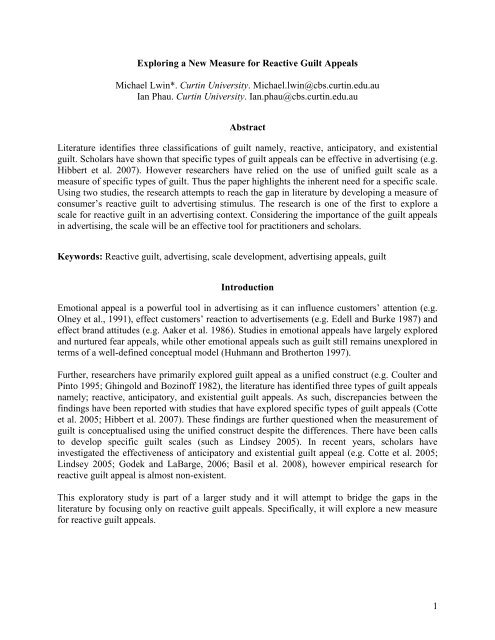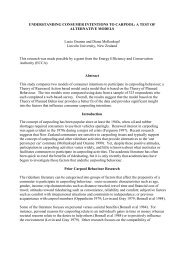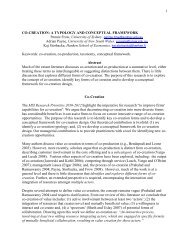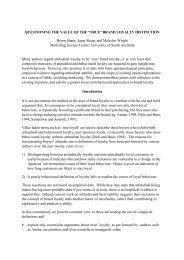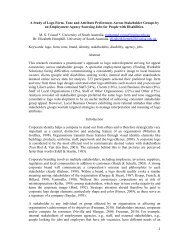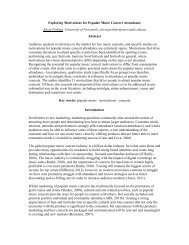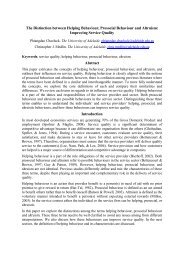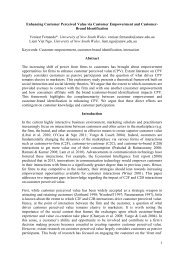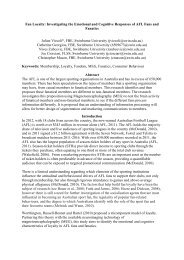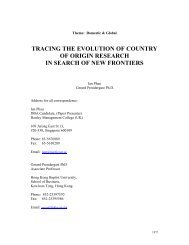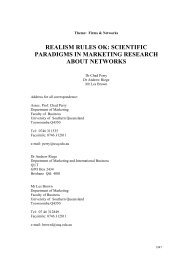1 Exploring a New Measure for Reactive Guilt Appeals ... - ANZMAC
1 Exploring a New Measure for Reactive Guilt Appeals ... - ANZMAC
1 Exploring a New Measure for Reactive Guilt Appeals ... - ANZMAC
You also want an ePaper? Increase the reach of your titles
YUMPU automatically turns print PDFs into web optimized ePapers that Google loves.
<strong>Exploring</strong> a <strong>New</strong> <strong>Measure</strong> <strong>for</strong> <strong>Reactive</strong> <strong>Guilt</strong> <strong>Appeals</strong><br />
Michael Lwin*. Curtin University. Michael.lwin@cbs.curtin.edu.au<br />
Ian Phau. Curtin University. Ian.phau@cbs.curtin.edu.au<br />
Abstract<br />
Literature identifies three classifications of guilt namely, reactive, anticipatory, and existential<br />
guilt. Scholars have shown that specific types of guilt appeals can be effective in advertising (e.g.<br />
Hibbert et al. 2007). However researchers have relied on the use of unified guilt scale as a<br />
measure of specific types of guilt. Thus the paper highlights the inherent need <strong>for</strong> a specific scale.<br />
Using two studies, the research attempts to reach the gap in literature by developing a measure of<br />
consumer’s reactive guilt to advertising stimulus. The research is one of the first to explore a<br />
scale <strong>for</strong> reactive guilt in an advertising context. Considering the importance of the guilt appeals<br />
in advertising, the scale will be an effective tool <strong>for</strong> practitioners and scholars.<br />
Keywords: <strong>Reactive</strong> guilt, advertising, scale development, advertising appeals, guilt<br />
Introduction<br />
Emotional appeal is a powerful tool in advertising as it can influence customers’ attention (e.g.<br />
Olney et al., 1991), effect customers’ reaction to advertisements (e.g. Edell and Burke 1987) and<br />
effect brand attitudes (e.g. Aaker et al. 1986). Studies in emotional appeals have largely explored<br />
and nurtured fear appeals, while other emotional appeals such as guilt still remains unexplored in<br />
terms of a well-defined conceptual model (Huhmann and Brotherton 1997).<br />
Further, researchers have primarily explored guilt appeal as a unified construct (e.g. Coulter and<br />
Pinto 1995; Ghingold and Bozinoff 1982), the literature has identified three types of guilt appeals<br />
namely; reactive, anticipatory, and existential guilt appeals. As such, discrepancies between the<br />
findings have been reported with studies that have explored specific types of guilt appeals (Cotte<br />
et al. 2005; Hibbert et al. 2007). These findings are further questioned when the measurement of<br />
guilt is conceptualised using the unified construct despite the differences. There have been calls<br />
to develop specific guilt scales (such as Lindsey 2005). In recent years, scholars have<br />
investigated the effectiveness of anticipatory and existential guilt appeal (e.g. Cotte et al. 2005;<br />
Lindsey 2005; Godek and LaBarge, 2006; Basil et al. 2008), however empirical research <strong>for</strong><br />
reactive guilt appeal is almost non-existent.<br />
This exploratory study is part of a larger study and it will attempt to bridge the gaps in the<br />
literature by focusing only on reactive guilt appeals. Specifically, it will explore a new measure<br />
<strong>for</strong> reactive guilt appeals.<br />
1
Background of <strong>Guilt</strong> in Advertising<br />
The persuasive nature of guilt appeals can be a powerful tool <strong>for</strong> advertisers (Cotte et al. 2005).<br />
That is, guilt can act as a motivating, action oriented emotion due to the unambiguous nature of<br />
the linkage between feeling of guilt and actions that led to its elicitation (Lewis 1993). Thus the<br />
individual will respond to a past failure due to the feeling of guilt and it will arouse the individual<br />
to reduce the feeling of guilt by making retributions. This phenomenon is also supported by the<br />
Negative State Model which suggests that individuals will seek to reduce these negative emotions<br />
(Cialdini and Kenrick 1976). <strong>Guilt</strong> is defined as a negative emotion there<strong>for</strong>e the individual will<br />
attempt to reduce the feeling of guilt by following a suggested course of action.<br />
A review of the literature shows that guilt construct has been demonstrated as an important<br />
variable in social marketing (e.g. Alden and Crowley 1995; Hibbert et al. 2007; Lindsey 2005),<br />
marketing communications (Ghingold 1980; Pinto and Priest 1991) and advertising (Cotte et al.<br />
2005; Coulter and Pinto 1995). It has also been empirically shown to influence consumer<br />
decision making process (Burnett and Luns<strong>for</strong>d 1994), ad and brand attitudes (Coulter and Pinto<br />
1995: Godek and LaBarge 2006), and donation intentions (Hibbert et al. 2007). While previous<br />
studies have focused on the use of guilt appeals in a social marketing context extensively (Alden<br />
and Crowley, 1995; Lindsey, 2005; Hibbert et al., 2007; Basil et al., 2008), the influences of guilt<br />
appeals in consumer products have been neglected and ignored (Coulter and Pinto, 1995). It is<br />
surprising since, Huhmann and Brotherton (1997) identified 51% of guilt ads were used in<br />
consumer durable and non-durable products.<br />
As suggested earlier there are three types of guilt; reactive guilt is defined as a response to the<br />
past and over an act of having violated those standards (Rawlings 1970). Out of the three guilt<br />
appeals, reactive guilt is considered as the most negative because it evokes past transgressions<br />
and there<strong>for</strong>e it evokes more negative emotions. Scholars have suggested that it creates a short<br />
term negative mood (Godek and LaBarge 2006). Additionally, reactive guilt appeals produced<br />
higher inferences of manipulative intent due to consumers reacting negatively towards the ad<br />
(Godek and LaBarge 2006). Consumers process reactive guilt ads systematically and every detail<br />
of the ad is questioned (Godek and LaBarge 2006). This enhances negative reactions towards the<br />
ad and consequently, advertisers tend to avoid the use of reactive guilt appeals (Huhmann and<br />
Brotherton 1997). In fact, Huhmann and Brotherton (1997) showed that only 29.4% guilt<br />
advertisements used reactive guilt appeals as an execution. Further, Huhmann and Brotherton<br />
(1997) showed that 17.8% of reactive guilt appeals were used in a consumer durable context. To<br />
this date only one study has explored the effects of reactive guilt (Godek and LaBarge 2006).<br />
Godek and LaBarge’s (2006) research had some limitations; firstly the stimulus was confined to a<br />
scenario that was given to the respondents. Secondly reactive guilt was measured using a general<br />
felt emotions scale. Thirdly, the effect of reactive guilt on behavioral intentions was shown to be<br />
significant, however the behavioral intentions scale was measured using a one item scale.<br />
There<strong>for</strong>e, the current research will attempt to resolve the measurement issues.<br />
Rawlings (1970) defined anticipatory guilt as guilt evoked when an individual contemplates a<br />
potential violation of one’s own standards. Past research shows that this type of guilt is more<br />
positive than others, as it can lead to action as a mean to avoid the feeling of guilt (Godek and<br />
LaBarge 2006; Lindsey 2005; Rawling 1970). Due to this unique characteristic anticipatory guilt<br />
is used more than other types of guilt. In fact, research indicates that over 61% of guilt<br />
2
advertisements applied the use of anticipatory guilt (Huhmann and Brotherton 1997).<br />
Additionally, Huhmann and Brotherton (1997) showed that a majority of anticipatory guilt ads<br />
are used in the non-durable consumer goods advertisements. Research to date has only explored<br />
anticipatory guilt in the following contexts, organ donation (Lindsey 2005), and financial services<br />
(Godek and LaBarge 2006).<br />
Existential guilt is defined as a comparison between one’s one wellbeing to the wellbeing of<br />
others and encourages action to bring the two closer together (Izard 1977). Charities often use<br />
this type of guilt appeal because their strategy fits well with the philosophy of existential guilt<br />
(Huhmann and Brotherton 1997). Hence charitable ads often attempt to evoke existential guilt to<br />
gain donations (e.g. Hibbert et al. 2007). Literature shows 21.6% of charitable ads used guilt<br />
appeals and 85.7% of these ads used existential guilt appeals (Huhmann and Brotherton 1997).<br />
Method and Results<br />
Two studies were conducted to explore a new measure of reactive guilt scale. Both studies were<br />
conducted using an experimental method in a classroom style setting. Scholars have suggested<br />
that respondent’s demographics could determine the intensity of guilt arousal (Hibbert el al.<br />
2007). Thus, to control <strong>for</strong> these variables subjects were delimited <strong>for</strong> the purposes of the two<br />
studies. For both studies, subjects aged between 18-24 years were used. This provided a more<br />
homogenous sample <strong>for</strong> the first two stages of the scale. Furthermore, two advertisements that<br />
highly evoked reactive guilt were used in the study.<br />
Study One<br />
The purpose of this study was to explore the concepts of reactive guilt. The scale development<br />
theory suggests that the existing theory should be consulted first to aid clarity with the scale<br />
(DeVellis 2003; Marcheigani and Phau 2007). Following the guidelines suggested by Li,<br />
Edwards and Lee (2002), three methods were used to generate potential scale items <strong>for</strong> reactive<br />
guilt. They are, literature reviews (Churchill 1979), thesaurus searches (Wells, Leavitt and<br />
McConville 1971), and expert surveys (Chen and Wells 1999; Churchill 1979). Using the three<br />
techniques an initial pool of 34 items was first developed.<br />
To test the scale items a print advertisement that evoked reactive guilt was used as a stimulus.<br />
The print advertisement was created <strong>for</strong> the study. To ensure that the advertisement is suitable <strong>for</strong><br />
the study an expert panel consisting of five people was used. The experts chose the developed<br />
print advertisement from a pool of eleven advertisements and thus it was chosen <strong>for</strong> the study. A<br />
survey instrument using the 34 items and demographics was developed. A total of two hundred<br />
twenty three useable responses were collected <strong>for</strong> the study. Scholars have suggested using<br />
Exploratory Factor Analysis (EFA) as the first step in scale development (DeVellis 1991) and<br />
thus EFA was conducted.<br />
The EFA showed two distinct factors of reactive guilt. The EFA process was used to remove<br />
items that are not suitable in the factors. Further, Cronbach’s Alpha was used to remove items<br />
with squared multiple correlations of less than 0.30 and correlated item-to-total correlation of less<br />
than 0.50 (DeVellis 1991; Marcheigani and Phau 2007). Weaker items and cross factor loaded<br />
3
items were also removed to optimise the scale. Finally we were left with nine items relating to<br />
reactive scale (α = .873) (KMO and Bartlett’s test = .874, Approx. Chi-Square = 997.425, Df =<br />
36, Sig. = .000).<br />
Study Two<br />
The purpose of this study was to further fine-tune the initial reactive guilt scale. Scholars have<br />
suggested using Confirmatory Factor Analysis (CFA) as a means of reducing the scale items to<br />
confirm the scale’s final <strong>for</strong>m. This study was designed to examine the unidimensionality of the<br />
scale items developed in Study One. If it is necessary the study also aims to further purify the<br />
scale items. To test <strong>for</strong> the scale’s unidimensionality, CFA analysis was conducted using AMOS<br />
15 software.<br />
A real broadcast ad from an unknown brand (Patek Philippe) lasting two minutes was used as the<br />
stimulus. It has been suggested that prior brand knowledge may have an impact on emotional<br />
response (Chattopadhyay and Basu 1990) thus a brand with limited knowledge was used <strong>for</strong> the<br />
study. The choice of the ad was tested using an expert panel consisting of six members rated the<br />
ad highly as evoking reactive guilt. The experts chose the advertisement from a pool of four<br />
broadcast advertisements. The advertisement shows the relationship between the father and the<br />
son, and how the father passed down his legacy by giving his watch to the son. The<br />
advertisement highlighted the fact that the son did not value the watch at the time and sold it off.<br />
However, when the son became a man and he himself became a father, he realises the value of<br />
his father’s watch. The advertisement showed the son having a strong emotional attachment with<br />
his father’s watch and felt reactive guilt <strong>for</strong> selling it. He searched and searched <strong>for</strong> his father’s<br />
watch and finally found it at an auction. Respondents were asked to position themselves as the<br />
son from the ad and how they will respond after seeing the ad. The respondents then recorded<br />
their reactions to the ad based on a number of scales on a self-administered survey.<br />
A survey instrument using the nine items from Study One and demographics was developed. A<br />
total of one hundred and seventy seven useable responses were collected. CFA is commonly used<br />
as the second step in scale development (Pedhazur and Schmelkin 1991) because it is considered<br />
as a superior technique than EFA <strong>for</strong> assessing unidimensionality (O’Leary-Kelly and Vokurka<br />
1998).<br />
The results show a further reduction of the scale items. CFA refined the scales resulting in a total<br />
of 7 items <strong>for</strong> reactive guilt with acceptable measures (Hu and Bentler 1999) (Chi-square =<br />
20.085, Degrees of freedom = 14, Probability level = .127, AGFI = .940, RMSEA = .050, RMR =<br />
.077, α = .891).<br />
4
<strong>Reactive</strong><br />
<strong>Guilt</strong><br />
Figure 1: Confirmatory Factor Analysis <strong>for</strong> <strong>Reactive</strong> <strong>Guilt</strong> Scale<br />
.67<br />
.70<br />
.76<br />
.87<br />
.79<br />
.76<br />
.79<br />
I felt guilty after buying… that I could not af<strong>for</strong>d<br />
I felt guilty <strong>for</strong> buying a very expensive…<br />
I felt ashamed when I spend excessively on…<br />
I felt guilty when others found out what I bought was very<br />
expensive<br />
I felt guilty <strong>for</strong> spending excessively on… as it was violating my<br />
acceptable standard<br />
I was disappointed with myself <strong>for</strong> spending excessively on…<br />
I felt guilty when I lied about my past spending on...<br />
Concluding Comments<br />
The paper has taken the first steps to develop a scale <strong>for</strong> reactive guilt. The final seven items <strong>for</strong><br />
the scale is illustrated in Figure 1. The scale fills an important gap in the literature as previous<br />
scales on guilt uses a unified construct. That is the three types of guilt, reactive, anticipatory and<br />
existential guilt are measured using one scale. Thus scholars could not measure the distinct<br />
influences of each type of guilt. The scale provides a researcher to manipulate and test the direct<br />
influence of reactive guilt. The scale could also be used by practitioners as a manipulation check<br />
to ensure that the advertisements elicited only the intended emotion. This will assist and provide<br />
a greater accuracy of results in consumer behaviour and advertising research.<br />
However, the scale is still in development and it needs further validation. Future studies should<br />
aim to develop construct and criterion validity of the scale. Scholars should also explore the<br />
generalisability of the scale by testing the scale in different media, consumer types and products.<br />
Researchers have shown that specific types of guilt appeals can be effective (e.g. Cotte et al.<br />
2005; Lindsey 2005; Godek and LaBarge, 2006; Basil et al. 2008; Hibbert et al. 2007). Lack of<br />
specific measure <strong>for</strong> each types of guilt has limited previous studies and this study takes one step<br />
closer to developing a stronger understanding of guilt appeals.<br />
e1<br />
G<br />
uil e2<br />
Gt<br />
uil e3<br />
Gt<br />
uil e4<br />
Gt<br />
uil<br />
e5 t<br />
G<br />
uil e7<br />
Gt<br />
uil e8<br />
Gt<br />
uil<br />
t<br />
5
References<br />
Aaker, D.A., Stayman, D.M. and Hagerty, R.M., 1986. Warmth in Advertising. <strong>Measure</strong>ment,<br />
Impact, and Sequence Effects. Journal of Consumer Research 12 (4), 365-381.<br />
Alden, D.L. and Crowley, A.E., 1995. Sex <strong>Guilt</strong> and Receptivity to Condom Advertising. Journal<br />
of Applied Social Psychology 25 (16), 1446-1463.<br />
Basil, D.Z., Ridgway, N.M., Nakamoto, K. and Basil, M.D., 1998. The Effects of <strong>Guilt</strong> and<br />
Empathy on Charitable Donations. Society <strong>for</strong> Consumer Psychology Conference, Austin, TX.<br />
Basil, D.Z., Ridgway, N.M. and Basil, M.D., 2008. <strong>Guilt</strong> and Giving: A Process Model of<br />
Empathy and Efficacy. Psychology and Marketing 25 (1), 1-23.<br />
Burnett, M.S. and Luns<strong>for</strong>d, D.A., 1994. Conceptualizing <strong>Guilt</strong> in the Consumer Decision<br />
Making Process. Journal of Consumer Marketing 11 (3), 33-43.<br />
Chattopadhyay, A. and Basu, K., 1990. Humor in Advertising: The Moderating Role of Prior<br />
Brand Evaluation. Journal of Marketing Research 27 (4), 466-476.<br />
Cialdini, R.B. and Kenrick, D.T., 1976. Altruism and Hedonism: A Social Development<br />
Perspective on the Relationship of Negative Mood State and Helping. Journal of Personality and<br />
Social Psychology 34 (5), 907-14.<br />
Chen, Q, Wells, W.D., 1999. Attitude Toward the Site. Journal of Advertising Research 39(5), 27-37.<br />
Churchill, G.A., 1979. A Paradigm <strong>for</strong> Developing <strong>Measure</strong>s of Marketing Constructs. Journal of<br />
Marketing Research 16 (1), 64-73.<br />
Cotte, J., Coulter, R.H. and Moore M., 2005. Enhancing or Disrupting <strong>Guilt</strong>: The Role of Ad<br />
Credibility and Perceived Manipulative Intent. Journal of Business Research 58 (3), 361-368.<br />
Coulter, R.H. and Pinto, M.B., 1995. <strong>Guilt</strong> <strong>Appeals</strong> in Advertising: What Are Their Effects.<br />
Journal of Applied Psychology 80 (6), 697-705.<br />
DeVellis, R.F., 1991. Scale Development: Theory and Application. Sage Publications.<br />
DeVellis, R.F., 2003. Scale Development: Theory and Application, 2 nd Edition, Sage Publications.<br />
Edell, J. A. and Burke, M.C., 1987. The Power of Feelings in Understanding Advertising Effects.<br />
Journal of Consumer Research, 14, 421-33.<br />
Ghingold, M., 1980. <strong>Guilt</strong> Arousing Marketing Communications: An Unexplored Variable. In:<br />
Monroe, K. B. (Eds.), Advances in Consumer Research, Association <strong>for</strong> Consumer Research,<br />
Ann Arbor, Michigan, 442-448.<br />
6
Ghingold, M. and Bozinoff, L., 1982. Construct Validation and Empirical Testing of <strong>Guilt</strong><br />
Arousing Marketing Communications. In: Mitchell, A. (Eds.), Advances in Consumer Research,<br />
Association <strong>for</strong> Consumer Research, Ann Arbor, Michigan, 210-214.<br />
Godek, J. and LaBarge, M.C., 2006. Mothers, Food, Love and Career-The Four Major <strong>Guilt</strong><br />
Groups? The Differential Effects of <strong>Guilt</strong> <strong>Appeals</strong>. Advances in Consumer Research 33 (1), 511..<br />
Hibbert, S., Smith, A., Davies, A. and Ireland, F., 2007. <strong>Guilt</strong> <strong>Appeals</strong>: Persuasion Knowledge<br />
and Charitable Giving. Psychology and Marketing 24 (8), 723-742.<br />
Huhmann, B.A. and Brotherton, T.P., 1997. A Content Analysis of <strong>Guilt</strong> <strong>Appeals</strong> in Popular<br />
Magazine Advertisements. Journal of Advertising 26 (2), 35-45.<br />
Izard, C. E., 1977. Human Emotions, Plenum, <strong>New</strong> York.<br />
Lewis, M., 1993. Self-conscious Emotions: Embarrassment, Pride, Shame and <strong>Guilt</strong>. In: Lewis,<br />
M., Haviland J.M. (Eds.), Handbook of Emotions, Guil<strong>for</strong>d Press, <strong>New</strong> York, 563-573.<br />
Li, H., Edwards, S.M., Lee, J., 2002. Measuring the Intrusiveness of Advertisements: Scale<br />
Development and Validation. Journal of Advertising 32 (2), 37-47.<br />
Lindsey, L.L.M., 2005. Anticipated <strong>Guilt</strong> as Behavioral Motivation An Examination of <strong>Appeals</strong><br />
to Help Unknown Others Through Bone Marrow Donation, Human Communication Research 31<br />
(4), 453-481.<br />
Marchegiani, C., and Phau, I., 2007. Advertising <strong>Appeals</strong> to “The Times of your Life”:<br />
Developing a Scale to <strong>Measure</strong> Personal Nostalgia. Australian and <strong>New</strong> Zealand Marketing<br />
Academy of Conference.<br />
Olney, T.J., Holbrook, M.B. and Batra, R., 1991. Consumer Responses to Advertising: the<br />
Effects of Ad Content, Emotions, and Attitude toward the Ad on Viewing Time. Journal of<br />
Consumer Research 17 (4), 440-453.<br />
O’Leary-Kelly, S.W., Vokurka, R.J. 1998. The empirical assessment of construct validity<br />
Journal of Operations Management 16, 387–405<br />
Pedhazur, E.J., Schmelkin, L.P., 1991. <strong>Measure</strong>ment, Design, and Analysis: An Integrated<br />
Approach. Lawrence Erlbaum Associates, Publishers, Hillsdale, NJ.<br />
Pinto, M.B. and Priest, S., 1991. <strong>Guilt</strong> <strong>Appeals</strong> in Advertising: An Exploratory Study.<br />
Psychological Reports 69 (2), 375-385.<br />
Rawlings, E.I., 1970. <strong>Reactive</strong> <strong>Guilt</strong> and Anticipatory <strong>Guilt</strong> in Altruistic Behavior. In: Macaulay,<br />
J.R., Berkowitz, L. (Eds.), Altruism and Helping Behavior, Academic Press, <strong>New</strong> York, 163-77.<br />
Wells, W.D., Leavitt, C. and McConville, M., 1971. A Reaction Profile <strong>for</strong> TV Commercials.<br />
Journal of Advertising Research 11 (6), 11-17.<br />
7


